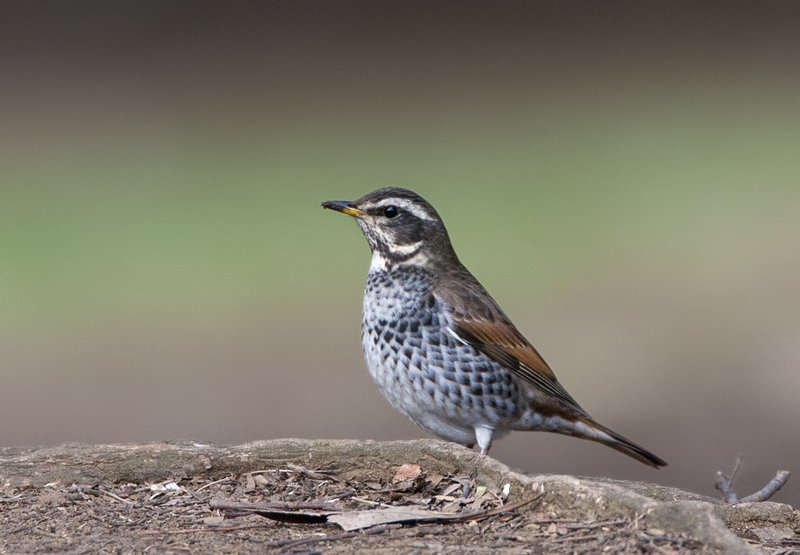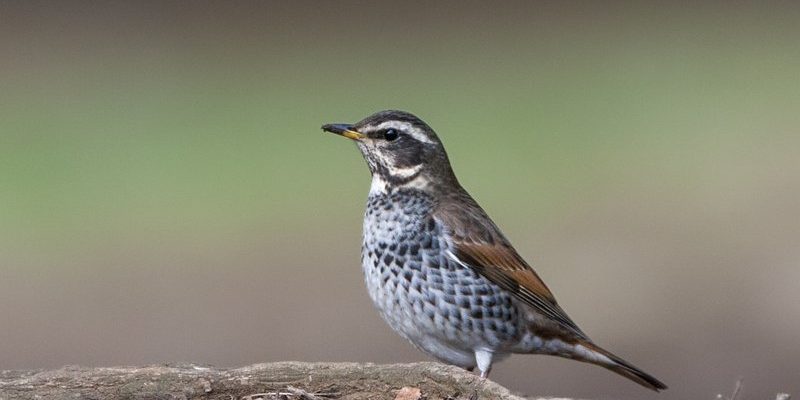
If you’ve ever been out in nature and heard a melodious, yet somewhat haunting song, you might have stumbled upon the beautiful Dusky Thrush. This bird, with its rich tones and striking appearance, is not just another feathered friend; it’s a remarkable creature with a story to tell. Imagine a cozy coffee shop filled with stories of the wild, and you’ll find the Dusky Thrush sitting right in the middle, captivating listeners with its charm and beauty.
The Dusky Thrush (Turdus eunomus) is a member of the thrush family, known for its distinctive songs and earthy colors. Found across various regions in Asia, particularly in eastern Siberia and parts of Japan, these birds are often seen in forests, gardens, and even urban areas. They are migratory, meaning that they travel long distances during seasonal changes, which adds an element of mystery to their behavior. Understanding the Dusky Thrush can deepen your appreciation for the biodiversity around us and highlight the importance of conserving these beautiful creatures.
Physical Characteristics
The Dusky Thrush is a medium-sized bird, typically measuring around 23 to 25 cm in length. Its plumage is a mix of earthy tones that allows it to blend seamlessly into its surroundings. The upper parts are predominantly brown with darker streaks, while the underparts are lighter with a creamy hue. One of the standout features is its distinctive spotted chest, which can resemble a modern art piece when viewed up close!
Another striking characteristic is its vivid yellow eye rings that contrast beautifully against its darker feathers. The Dusky Thrush has a long, relatively straight beak that is well-suited for its diet, which consists of fruits, berries, and insects. This diet plays an important role in its habitat, as these birds help spread seeds and pollens, further supporting their ecosystem.
When it comes to their feathers, they possess a unique texture that seems to shimmer in the sunlight, giving them an almost ethereal appearance. This visual beauty might remind you of a painter’s stroke or a melody’s rise and fall – both intricate and natural. Their songs, comprising whistles and trills, can easily fill a quiet forest with a soundtrack of nature’s finest tunes.
Habitat and Range
The Dusky Thrush thrives in a variety of habitats, but it predominantly prefers temperate forests, gardens, and scrublands. During the breeding season, which can vary but often falls in the late spring, they are mainly found in eastern Siberia and parts of Mongolia where they can nest comfortably among the shrubs and trees. Their nests are usually hidden, skillfully concealed to protect young chicks from predators.
In the colder months, these birds embark on a migratory journey that takes them to warmer regions, including parts of China and Japan. It’s fascinating to think about how far these little creatures travel, often returning to the same spots each year. This behavior highlights their incredible navigation skills and adaptability. You might wonder what drives them to travel such vast distances, and it’s mostly for food and suitable breeding grounds.
To understand the Dusky Thrush better, it’s essential to recognize its role in the ecosystem. As a species that thrives in various environments, it contributes to seed dispersal and pest control. By munching on fruits and insects, the Dusky Thrush helps maintain the balance of its habitat, a fact that’s often overlooked when we admire these birds from afar.
Diet and Feeding Habits
The diet of the Dusky Thrush is as diverse as its song. Primarily, these birds feast on fruits and berries during the warmer months. They have a knack for finding ripe berries and often eat them straight from the bushes. You might find them hopping around gardens or fields, where they search for delicious insects, especially during spring and summer. Insects are a critical source of protein, particularly when they’re feeding their young.
During the winter months, when food is scarce, their diet shifts, and they continue to rely heavily on dried fruits and seeds. This adaptability is a testament to their survival instincts. Just picture a Dusky Thrush in a wintry landscape, digging through the snow for hidden berries. It’s a real-life testament to resilience in the wild!
Interestingly, the Dusky Thrush is also known for its occasional foraging habits, which can include scavenging in urban areas or even dining at bird feeders set up by people. These birds can be quite clever, finding ways to access food even when it’s not in their natural habitat. This behavior not only helps them survive but also fosters a beautiful connection between nature and humans.
Behavior and Social Structure
Dusky Thrushes are generally social creatures, often found in small groups, particularly outside of the breeding season. Their social nature can be quite endearing as they flit about, chirping to each other in a lively manner. You might often see them engaged in playful interactions, chasing one another or taking turns foraging in a favored spot. This camaraderie among birds is a charming sight to witness, reminiscent of friendly gatherings among pals at a park.
During the breeding season, however, they become more territorial. Males will often sing from elevated perches, using their beautiful songs to attract females and defend their nesting territory. It’s a bit like a concert where the male is the star performer, showcasing his vocal prowess to woo potential mates. You can imagine the anticipation in the air as a female listens intently, looking for the best performer!
Moreover, Dusky Thrushes are also known for their remarkable mimicry skills. They can imitate the calls of other bird species, adding variety to their song repertoire. This talent can be beneficial in confusing predators or rivals while attracting mates. Their voices blend into a beautiful symphony, echoing through their environments, captivating anyone lucky enough to hear them.
Conservation Status
Currently, the Dusky Thrush is classified as “Least Concern” by the IUCN, which means that they’re not facing immediate threats of extinction. However, like many species, they are vulnerable to habitat loss due to urban development and climate change. As their natural habitats shrink, it becomes essential to advocate for conservation efforts that protect their breeding and wintering grounds.
Birdwatchers and nature enthusiasts play a crucial role in raising awareness about these beautiful birds. By sharing observations and experiences, people can foster a sense of appreciation and urgency regarding the preservation of natural habitats. You might be surprised by how much positive impact one person can have, simply by spreading the word and encouraging others to appreciate the beauty of nature.
Furthermore, supporting local conservation organizations can lead to significant advancements in preserving the habitats that Dusky Thrushes and many other wildlife depend on. Every small effort counts, whether it involves planting native plants in your garden or participating in local clean-up campaigns. It’s a reminder that we all share this planet and bear a responsibility to protect it for generations to come.
Interesting Facts
| Scientific Name: | Turdus eunomus |
| Length: | 23-25 cm |
| Wingspan: | 34-38 cm |
| Diet: | Fruits, berries, and insects |
| Habitat: | Temperate forests and gardens |
| Nesting: | Shallow cup nests in shrubs |
| Migratory Pattern: | Breeds in the north; migrates south for winter |
| Song: | Melodious, varied whistles and trills |
FAQ
What do Dusky Thrushes look like?
The Dusky Thrush is a medium-sized bird with a distinctive brownish plumage, featuring darker streaks on its back and a lighter, spotted chest. Its striking yellow eye rings and well-defined markings set it apart from other birds in the thrush family, making it a delightful sight when seen in the wild. Their coloration helps them blend harmoniously with their natural environment, providing them concealment from predators.
Where do Dusky Thrushes migrate to?
Dusky Thrushes migrate from their breeding grounds in eastern Siberia and Mongolia to warmer regions in China and Japan during the winter. This migration is essential for their survival, as it allows them to seek food and favorable conditions during the colder months. Their ability to navigate vast distances is a remarkable aspect of their behavior as they instinctively know when to make the journey.
What do Dusky Thrushes eat?
The diet of the Dusky Thrush primarily consists of fruits, berries, and insects. They enjoy foraging on the ground and in bushes, seeking out ripe berries during the summer months. In winter, they adapt by eating dried fruits and seeds, showcasing their remarkable ability to adjust their diet based on available food sources.
Are Dusky Thrushes social birds?
Yes, Dusky Thrushes are generally social and often found in small groups outside of the breeding season. They engage in playful interactions and communicate through various calls. However, during the breeding season, male Dusky Thrushes become more territorial to attract females and defend their nesting areas.
How can I help protect Dusky Thrushes?
You can help protect Dusky Thrushes by supporting local conservation efforts, planting native plants in your garden, and promoting awareness about their importance in the ecosystem. Simple actions, like reducing pesticide use, can also create a safer environment for them and other wildlife.
What are the threats to Dusky Thrushes?
Threats to Dusky Thrushes mainly include habitat loss due to urban development and climate change. As their natural habitats shrink, it becomes vital to advocate for conservation measures that protect their breeding and wintering grounds. Environmental awareness can go a long way in securing a safe home for this beautiful bird.
Can Dusky Thrushes mimic other birds?
Yes, Dusky Thrushes are known for their mimicry skills. They can imitate the calls of other bird species, which adds variety to their songs. This remarkable ability can help them confuse predators and rivals while also attracting potential mates. It’s a fascinating feature that highlights their adaptability!
When do Dusky Thrushes breed?
Dusky Thrushes typically breed in late spring, depending on their location. They build their nests in hidden places among shrubs and trees to protect their eggs and young from predators. The male often performs songs to attract a mate during this period, creating an enchanting atmosphere of courtship.
What role do Dusky Thrushes play in their ecosystem?
Dusky Thrushes play an essential role in their ecosystem by aiding in seed dispersal and pest control. By eating fruits and berries, they help spread seeds, contributing to plant reproduction. Their diet also includes insects, which helps control pest populations, showcasing their vital role as a natural part of the ecosystem.
Do Dusky Thrushes have any predators?
Like many birds, Dusky Thrushes have a variety of natural predators. These can include larger birds of prey, snakes, and even domestic cats. Their ability to blend into their environment helps them avoid detection, but they must remain vigilant, especially during nesting season when they are more vulnerable.
What is unique about the Dusky Thrush’s song?
The Dusky Thrush’s song is noted for its melodious quality and can include a variety of whistles and trills. This rich vocalization not only serves an important role in communication but also attracts mates during the breeding season. The beauty of their song is often celebrated by birdwatchers and nature enthusiasts alike.

